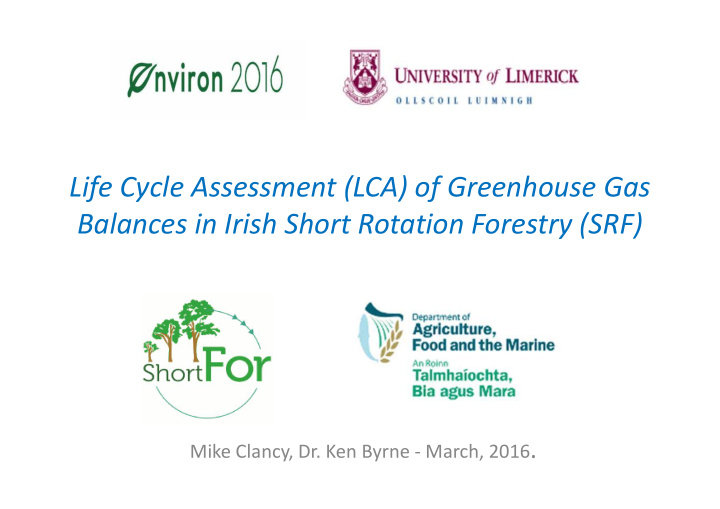



Life Cycle Assessment (LCA) of Greenhouse Gas Balances in Irish Short Rotation Forestry (SRF) Mike Clancy, Dr. Ken Byrne - March, 2016 .
ShortFor: Project overview • ShortFor? – Project funded by Dept. of Agriculture Forestry and the Marine (DAFM). – Aim: Assess the environmental and economic impacts of Short Rotation Forestry (SRF) biomass for renewable bioenergy. • SRF? – In this project SRF is confined to single stem species suitable to Irish climate and soil conditions. – Plantations managed over rotations of 10-15 years. – Minimum planting density of 2,500 stems ha -1 . • Potential Irish SRF genera? – Eucalyptus, Italian Alder, Hybrid aspen & Poplar clones. – As specified in the DAFM 2014-2020 “Forestry for Fibre” grant and premium scheme.
LCA framework and applications • LCA is a method of comparing products and services using the framework outlined below, which can identify environmental impacts attributable to resource consumption, emissions and wastes (Pennington et al, 2004). • The LCA is usually conducted via specialised software tools and databases, e.g. openLCA v1.42 and ecoinvent v3.1, respectively. Source: ISO 14040, 2006
ShortFor: LCA definition • Goal: – To assess the greenhouse gas (GHG) balance of Irish SRF, in terms of reaching the goal of 16% renewable energy by 2020. – Provide environmental data to assist policy makers in energy, land- use, and forestry planning, and to determine appropriate levels of incentives for SRF bioenergy. • Scope: – SRF: Eucalyptus and Alder, over two 15 year rotations – SRF bioenergy: Cradle-to-grave (nursery to ash disposal) – The “functional unit”, which is a quantitative measure of the functions that the product or service provide, is 1 GJ of energy.
LCI, LCIA, Interpretation 1. Life Cycle Inventory (LCI): – A compilation of the inputs (resources & energy) and outputs (e,g, GHG emissions) from the product or service over its life- cycle, each defined in relation to the functional unit. 2. Life Cycle Impact Assessment (LCIA): – The LCIA is aimed at evaluating the magnitude and significance of the potential environmental impacts of the studied system using specified indicators (e.g. global warming potential (GWP), eutrophication, acidification). 3. Interpretation: – Results from the previous phases are evaluated in relation to the goal and scope in order to reach conclusions and recommendations.
SRF LCA system boundary & process map • • Plant production Site preparation & planting • Seedling propagation • Drainage • Weed control • Plant growth • Sub-soiling • Pest control • Plant transport on-site • Fencing • Planting • Plant transport to plantation site • Liming • Fertilisation • SRF harvesting • Fuelwood preparation • Mechanical harvesting • Woodchip storage • Forwarding on-site • Woodchip drying • Chipping at roadside • Woodchip transport to energy plant • Woodchip transport off-site • Woodchip combustion • Woodchip handling/mixing Functional unit: 1 GJ of energy • Combustion in boiler • Ash disposal
Harvesting operations: stems, whole-tree, and stumps
18 yr. old Eucalyptus ( E. nitens ) beside 19 yr. old Sitka spruce, Cappoquin, Co Waterford (Thompson et al, 2012)
Comparison of tree biomass over 10-20 yr. rotations Source: Forestry Commission, 2011
Scenarios & Assumptions for LCA • Reference system, for SRF LCA comparison – Bioenergy from conventional forest & industrial residues • Land use change (LUC) – Conversion of marginal agricultural land to SRF • Harvest options: – Conventional forest (Sitka spruce) thinning’s and brash/residues – SRF stems only – SRF whole-tree – SRF whole-tree + stumps • Transport options: – On-site mechanical forwarding to wood-chipper, set at 250 and 500 m – Off site haulage of woodchips (@ 50% MC), set at 50 and 100 km • Combustion options: – Electricity generation at EPL – 35% efficiency – CHP at commercial site – 80% efficiency
ShortFor LCA: Nursery seedling process
LCA systematic procedures: Uncertainty & Sensitivity Analyses • Uncertainty analysis – Quantifying the uncertainty in the LCI results due to the cumulative effects of model imprecision, input uncertainty, and data variability. – E.g., field emissions are highly dependent on LUC, local climate, soil properties, and site management practices. • Sensitivity analysis – Estimating the effects of the choices made regarding methods and data on the study results.
In conclusion Overall aim of the project: • To evaluate the GHG balance of SRF through LCA to see if it can positively contribute to our renewable energy goals – 16 % by 2020. Relevance to Sustainable Land Use: • Biomass production is an ecosystem service Acknowledgements: Project funding provider – DAFM • • My supervisor – Dr. Ken Byrne • ShortFor project partners: UCD, WIT, Coillte, Teagasc, TCD. Thank you for your attention.
Recommend
More recommend